You need to upgrade your Flash Player
Please visit Adobe's Flash Player site to upgrade the most recent version.
Thank you.
If you are having issues with installing Adobe Flash Player, please make sure that all "pop-up killer" applications are turned off and you reinstall
the Adobe player.
Delos island
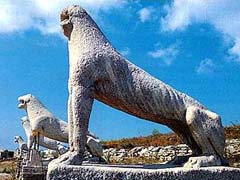
About Delos
general information
- Delos belongs to the Cyclades islands cluster
- Area: 6 square km
- Member of the World Heritage List of UNESCO
- No tourist development except for small boats making daily tours
- Inhabited only by the keepers of the archeological site
- Daily connection with Mykonos
- Connection with other Cycladic islands by small local boats

Delos was the most important Panhellenic sanctuary, and, according to mythology, the birth-place of Apollo and Artemis.
The first signs of habitation on the island date from the 3rd millenium B.C., and important remains of the Mycenaean period have been uncovered in the area of the sanctuary. In the 7th century B.C. Delos was already a known Ionic centre because of its religious importance as the birth-place of Apollo.
Athenian influence was initiated on the sanctuary with the first purification of Delos by Peisistratos in 540 B.C. but it gradually developed into a proper domination lasting - with short intervals - until the end of the 4th century B.C., when Delos was finally declared free and independent (314 B.C.). The independence of the island lasted until 166 B.C. when the Romans gave it over to the Athenians.
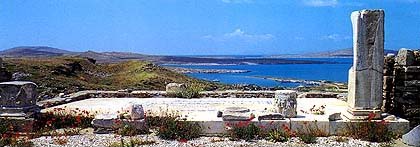
Numerous pieces of sculpture were transferred to Museums of Greece and abroad, while marbles from the ancient buildings were used as building material by the inhabitants of the nearby islands. Excavations on Delos started in 1873 by the French School of Archaeology at Athens. Between 1904 and 1914, under the direction of M. Holleaux and thanks to the donation of Duke de Loubat, the most significant sections of the ancient site were uncovered. Intensive excavations were conducted in the years 1958-1975. The excavations are still carried out by the French School of Archaeology, but the religious, political and commercial centre of the island has already been revealed along with many private houses. Restricted excavations were also conducted by Greek archaeologists at the beginning of the century.
Large-scale restoration work has been undertaken by the French School of Archaeology mainly in the sector of the private houses, but in the recent years, the 21st Ephorate of Prehistoric and Classical Antiquities has also carried out similar work. Several columns have been rebuilt and ancient houses have been roofed in order to protect the mosaic floors (House of the Trident, House of the Masks, House of Hermes). In 1990 Delos was included in the World's Cultural Heritage, protected by the UNESCO.
The most important monuments of the site are:
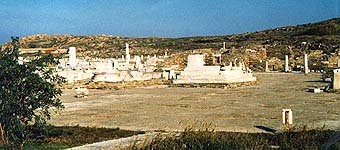 The Agora of the Competaliasts:
The Agora of the Competaliasts: One of the main markets of the Hellenistic city is an open square directly abutting the Sacred Harbour, paved with large flat stones of gneiss, many of which have post-holes for tents.
On the north side lies the Portico of Philip and a small Ionic temple dedicated to Hermes, the god of commerce, while shops and workshops flank the market along the east and south sides. At the centre of the square stand the foundations of two marble monuments (one square and one round), also dedicated to Hermes. Around them, bases of monuments erected by bankers, ships' pilots and merchants are to be seen. The whole complex is dated to the last quarter of the 2nd century B.C.
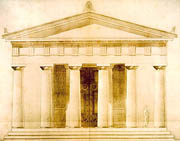 The Temple of the Delians
The Temple of the Delians The Temple of the Delians or Grand Temple is the latest and largest of the three temples dedicated to Apollo.
It is a "peripteral" Doric temple with six columns on each of the narrow sides and thirteen on each of the long ones. Its construction began in 478 B.C. but stopped around the middle of the 5th century B.C., when the League' s treasury was transferred to Athens. Work was resumed later on, during the period of Delian independence, but was never actually finished.
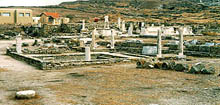 The Minoan Fountain
The Minoan Fountain The Minoan Fountain, referred to in the inscriptions and identified by a relief bearing a dedication to "Minoan Nymphs", is a public well hewn in the rock. It was covered by a square building, open on the south side, which was flanked by a Doric portico. The water level could be reached by the stone steps on the south side. The fountain was constructed in the second half of the 6th century B.C. and remained in use for a very long time, until the late Hellenistic period, when it was finally converted into a house.
Terrace of the Lions
The marble lions dedicated to Apollo by the Naxians at the end of 7th century B.C. stand in a row facing eastwards, towards the Sacred Lake. They are reckoned originally to have been sixteen in number, but only five lions and the remains of three more, standing on modern bases, can be seen in position today. The headless body of another lion now decorates the Arsenal in Venice. Bordering the west side of the road leading from the harbour in Skardana bay to the temples, they were the eternal guardians of the Sanctuary.
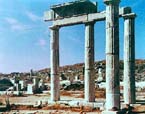 The Establishment of the Poseidoniasts from Beirut
The Establishment of the Poseidoniasts from Beirut It was the club house of an association of Syrian shippers, merchants, bankers, and warehousemen bound up by their desire for racial kinship and the desire to worship the national gods but also for the protection of their commercial interests.
It consists of a central peristyle court, around which are arranged various rooms and temples dedicated to Poseidon, Hercules and Rome. Dated to the last quarter of the 2nd century B.C.
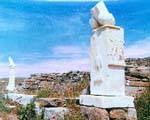 The Stoivadeion
The Stoivadeion Rectangular platform to the NW of the Sanctuary, containing a statue of Dionysos flanked by two actors impersonating Paposilenoi (now in the Museum).
On either side of the platform, a pillar supports a huge phallus, the symbol of Dionysos. The southern pillar, which is decorated with relief scenes from the Dionysiac circle, was erected in ca. 300 B.C. by a Delian named Karystios in order to celebrate a victorious theatrical performance sponsored by him.
 The Theatre
The Theatre The preserved marble theatre was constructed at the beginning of the 3rd century B.C. and replaced an earlier, wooden one. The upper (epitheatron) and the lower part of the theatre, which are separated by the diazoma, are not concentric.
The first row of seats, which is for the privileged, is followed by twenty-six stone tiers in the lower part and seventeen more in the epitheatron, divided by eight stairways into seven cunei, that could accommodate about 5.500 spectators. In front of the round orchestra, the remains of the stage-building (skene) are to be seen.
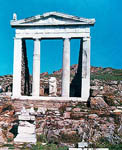 Temple of Isis
Temple of Isis Small Doric temple within a sanctuary shared by the familiar triad Serapis, Isis and Anubis, located on a high terrace by the foothill of Cynthus. Built at the beginning of the 2nd century B.C., it was repaired by the Athenians in 135 B.C. and still contains the cult statue of the goddess. Isis, known by a variety of cult names, gave people good health and fortune and protected the sailors.
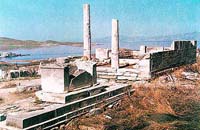 The Temple of Hera
The Temple of Hera Doric temple constructed in around 500 B.C.; under its cella were revealed the foundations of an earlier temple, dating back to the beginning of the 7th century B.C. In the remains of this earlier temple, a large number of Archaic vases and other votive offerings were found (now exhibited in the museum), many of which bear incised votive inscriptions to Hera. The altar of the goddess was erected to the south of the temple.
The House of Dionysos
The "House of Dionysos", thus named after the famous mosaic floor depicting Dionysos riding a panther, is a good example of a private residence, dating from the last quarter of the 2nd century B.C. A covered passage leads from the entrance to a peristyle court, on which open the rooms of the ground floor. At the centre of the court there is a cistern for the collection of water, covered with a splendid mosaic floor. A stone stairway leads to the elegant private rooms of the upper storey.
Travel in Cyclades
- Cyclades islands
- All Cyclades islands
- Amorgos island
- Anafi island
- Andros island
- Antiparos island
- Delos island
- Donoussa island
- Folegandros island
- Heraklia island
- Ios island
- Kea (Tzia) island
- Keros island
- Kimolos island
- Koufonissia islands
- Kythnos island
- Milos island
- Mykonos island
- Naxos island
- Paros island
- Santorini island
- Schinoussa island
- Serifos island
- Sifnos island
- Sikinos island
- Syros island
- Tinos island

